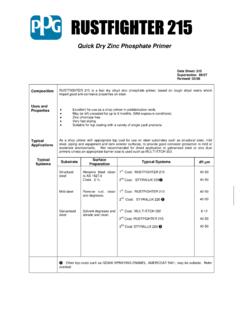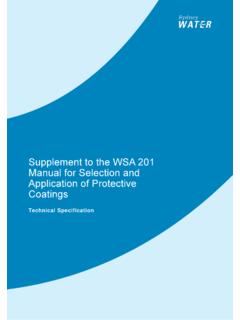Transcription of An Introduction to Autophoretic Coatings - …
1 An Introduction to Autophoretic Coatings Now part of the Coatings Technology Platform What is autodeposition? Autodeposition Mechanism Autodeposition is a method of applying a layer of anti-corrosive paint to metal using a = Stable Latex = Latex destabilized chemical reaction. Henkel provides by Fe2+ ions autodeposition products under the brand names Autophoretic coating Chemicals 2 Fe2+. and Aquence Coatings Chemicals. Fe Fe 2 Fe2+. Fe3+ Fe3+. The autodeposition process has been in commercial use since 1975, and has grown to include more than 130 commercial installations in 22 countries. Since its inception, this simple and reliable industrial Figure 1. coating process has coated billions of square feet of surfaces for a wide variety of If you immerse a component made from applications. ferrous metal (shown as the grey oblong above) into the bath, there is surface attack There are as many similarities to electro- from both the ferric fluoride and the acid.
2 Less plating and conventional painting This results in the liberation of ferrous ions techniques. Electro-less plating provides that will destabilize the emulsion locally at many unique features that enable the the metal surface, causing the paint layer to coating of components not possible by other be deposited. systems. Autodeposition Mechanism How does autodeposition work? The process consists of four basic steps: Fe++. Fe++ Fe++. 1. Clean the metal 2. Apply the coating Fe Fe++. 3. Rinse off any unreacted material Fe++. Fe++. 4. Oven dry Fe++. The unique step is the coating bath itself, where a dispersion of a paint emulsion at low solids (usually around 4-6% w/w) is Figure 2. made. A starter solution of acidified ferric (Fe3+) fluoride is added to the bath. The Figure 2 illustrates iron trapped in the coating emulsion is stable in the presence of deposited paint film so that the deposited ferric ions, but unstable in the presence of coating is made up of latex (emulsion), ferrous ions (Fe2+).
3 Therefore, if ferrous ions pigment and iron. This unique combination are produced at the surface, local paint is the reason autodeposition Coatings deposition will occur on the metal surface, provide an exceptionally hard, yet flexible, which is then baked to produce a coating . coating . The deposited iron gives a pencil This process is illustrated in Figures 1 and hardness of 5-6H, yet the coating will not 2. crack even when folded and crimped to 0-T. bend. How do I control the coating A typical autodeposition coating process thickness? consists of seven stages plus oven curing: 1. Alkaline spray cleaner coating thickness is controlled in a number 2. Alkaline immersion cleaner of ways. Because the coating depends on 3. City water rinse the diffusion of ferric ions to the surface and 4. De-ionised water rinse ferrous ions from the surface, the deposition 5. Autodeposition immersion rate slows down over time and will self-limit 6. City water rinse to a certain extent, as illustrated in Figure 3.
4 7. Reaction rinse Autodeposition Oven cure, depending on ACC product type. Simple Process Control Film Thickness A photograph of a typical programmable 35. hoist line is shown in Figures 4 and 6. A. 30. schematic of a typical conveyor line is Thickness (Microns). 25. shown on the front cover, as well as in 20. Figures 5 and 7. 15. 10. What performance can I obtain? 5. 0. 0 10 20 40 60 80 100 120 140 160 180 Performance depends of the product type coating Time (seconds) and requirements. For example, ACC 800. Figure 3 Series is a low-bake product widely used for metal, rubber and plastic composites. ACC. This process is not the only way of 900 Series is designed for use in areas controlling the coating thickness. Mixers are subjected to higher operating temperatures, used in the paint bath to agitate the bath and is suited for use as a primer under and bring fresh chemistry to the surface. powder Coatings and liquid baking enamels. This means that increasing or decreasing the mixer speed can significantly affect the Typical performance properties are listed in number of microns deposited.
5 Figures 8 and 9. Performance is affected by many variables, including surface The deposition rate also can be impacted cleanliness, rust and surface hardness. with the addition of an activator to increase Therefore, Henkel provides a free test coat the reactivity of the bath. of components, enabling customers to evaluate the process and its performance. An interesting feature of the process is the stability of the bath. There are no heavy anti-corrosive pigments in the bath to cause sedimentation. The acidic nature of the bath also means it does not suffer from bacterial attack. This means that the ACC bath can be left without agitation; for example, over shut down periods without harm. The typical process Autodeposition lends itself to production using chain conveyor systems, hoist systems and power and free mechanisms. Theoretically, no electrodes are necessary for the process so flood coating is possible. Typical autodeposition equipment layout for hoist operations Figure 4.
6 Typical autodeposition equipment layout for conveyor operations Figure 5. Typical programmable hoist installation Figure 6. Photograph courtesy of the Autocoat Company Limited, UK. Typical monorail conveyor installation Figure 7. Typical product performance characteristics of ACC products Figure 8 (Metric). Autophoretic Autophoretic . TEST. 915/E3 866/2150. RESIN TYPE EPOXY/ACRYLIC PVDC. FILM THICKNESS 15-25 Microns 12-25 Microns 1mm CROSS HATCH ADHESION NO FAILURE NO FAILURE. GLOSS @ 60 40 - 80 5 -10. PENCIL HARDNESS H - 3H 4H - 7H. T Bend Test 1T 0T. HUMIDITY. PASS PASS. (1000 HOURS). WATER SOAK. PASS PASS. (240 HOURS). CYCLIC CORROSION. 40 cycles 40 cycles SAE J2334. NEUTRAL SALT SPRAY. 500 Hours 500 hours+. SCRIBE. HUMIDITY 1000 HOURS 1000 HOURS+. TEMPERATURE RESISTANCE 220 C <120 C **. Two Zone CURE TEMPERATURE - 75 C 100 - 110 C. - 200 C. Note: Initial cured film performance on UMA 1800 test panels, coated in our laboratories to appropriate DFT.
7 Performance on production parts or other substrates may vary. Figure 9 ( Standards). A U T O P H O R E T IC A U T O P H O R E T IC . TEST. 9 15 /E 3 8 6 6 /2 1 5 0. R E S IN T Y P E E P O X Y /A C R Y L IC PVDC. F IL M T H IC K N E S S (M IL S ) 0 .6 1 .0 0 .5 - 1 .0. C R O S S H A T C H A D H E S IO N N O F A IL U R E N O F A ILU R E. G L O S S @ 6 0 4 0 - 80 5 -1 0. P E N C IL H A R D N E S S H - 3H 4 -7 H. 1 2 0 - 1 6 0 IN -L B S . R E V E R S E IM P A C T 6 0 - 8 0 IN -L B S . ( -0 .7 M IL S ). M A N D R E L T E S T (G M 9 50 3 P ) 10 10. H U M ID IT Y. PASS PASS. (1,0 0 0 H O U R S ). W A T E R IM M E R S IO N. PASS PASS. (24 0 H O U R S ). G M 9 5 4 0 P S C R IB E 40 c yc les 4 0 c yc les S A E J 2 33 4 S C R IB E 40 c yc les 4 0 c yc les N E U T R A L S A LT S P R A Y. 5 0 0 h ou rs 5 00 + h ours S C R IB E. N E U T R A L S A LT S P R A Y. 10 0 0 H O U R S 1000 H O U R S +. N O S C R IB E. T E M P E R A T U R E R E S IS T A N C E 4 25 F < 2 5 0 F **.
8 T w o Z on e 15 0 -1 65 F an d CURE TEMPERATURE 2 1 0 - 2 2 0 F. 3 50 - 39 5 F. Note: Initial cured film performance on ACT cold rolled steel panels, ARP10354 to appropriate DFT. Performance on production parts or other substrates may vary.. **Temperature resistance of Autophoretic Coatings is dependent on exposure duration and airflow conditions. Life cycle testing for parts is recommended. New Aquence coating Products Henkel Aquence 925G is a new epoxy/acrylic urethane coating that provides the performance advantages of autodeposited epoxy-acrylic urethane Coatings , and features a lighter color base for top coating with powder and liquid paints. Applications include any ferrous metal part or structure requiring superior cyclic corrosion protection, thermal stability and good top coat ability. The ability of Aquence 925G to provide a lighter color primer base and precise film thickness enables decreased paint consumption and improved top coat color control.
9 Film Properties: TEST Aquence 925G/E2. FILM THICKNESS (MILS) ( ). CROSS HATCH ADHESION NO FAILURE. GLOSS @ 60 30 50. PENCIL HARDNESS H - 3H. COLOR Light to Dark Gray REVERSE IMPACT 60 - 120 IN-LBS. STONE CHIP (-30 C) PASS. Anti-Corrosion Properties: TEST Aquence 925G/E2. Average Total Scribe Creep GM 9540P SCRIBE (20 Cycles) 3 mm SAE J2334 SCRIBE (20 cycles) 3 mm NEUTRAL SALT SPRAY SCRIBE (504. 3 mm hours). SALT SPRAY NO SCRIBE (1000 hrs) <5% Rust STONE CHIP (-30 C) PASS. HUMIDITY (1,000 HOURS) NO FAILURE. The information contained herein is based on information believed to by Henkel to be accurate at the date of testing. No guarantee of performance is given. Additional or updated information may be obtained by contacting Henkel Corporation. Future Aquence Products In 2008, Henkel Aquence 930 coating will debut, delivering enhanced corrosion performance to demanding applications such as vehicle frames and chassis components. Aquence 930 has achieved 1000 performance hours on Neutral Salt Spray (NSS) testing and performed similar to Cathodic E-Coat (CED) + zinc phosphate pre-treatment on automotive OEM cyclic corrosion tests.
10 This epoxy-acrylic urethane coating has excellent thermal stability, top coat ability and flexibility. Its best-in-class environmental footprint is further improved with even lower Volatile Organic Compounds (VOCs) and the elimination of Hazardous Air Pollutants (HAPs). Film Properties: TEST Aquence 930/E3. FILM THICKNESS (MILS) ( ). CROSS HATCH ADHESION NO FAILURE. GLOSS @ 60 30 50. PENCIL HARDNESS H - 3H. COLOR Black REVERSE IMPACT 60 - 120 IN-LBS. SOLVENT RESISTANCE (MEK ) > 100 MEK-DR. SAE J400 Gravelometer (-30 C) Pass ASTM D3170 (2-4A). Anti-Corrosion Properties: TEST Aquence 930/E3. Average Total Scribe Creep 1008 hrs NSS, ASTM B-117 3mm total creep 40 Cycles GM 9540 P 3mm total creep 40 Cycles SAE J2334 3mm total creep 1008 hrs NSS, ASTM B-117 after heat soak 6 mm total creep (48hrs in 204 C). 240 hrs Humidity, D1735 mm creep from X scribe Water soak FLTM BI 104-01 No adhesion loss, 120hrs The information contained herein is based on information believed to by Henkel to be accurate at the date of testing.





